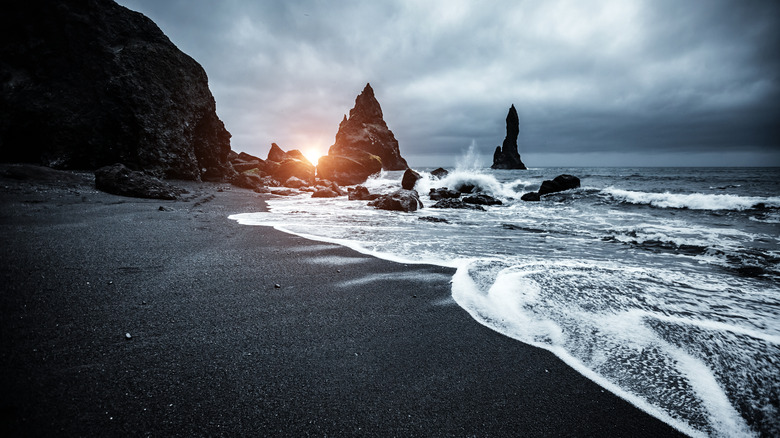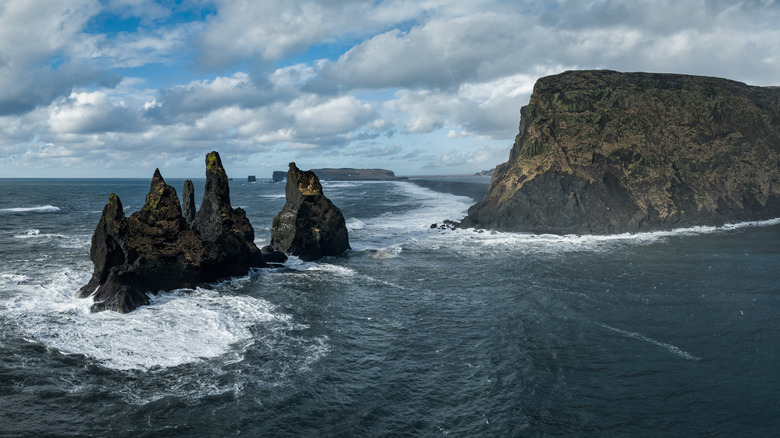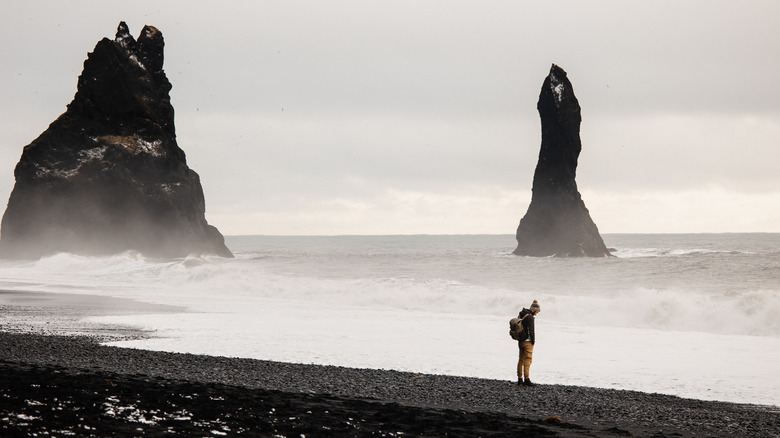The Scary Reason You Should Think Twice Before Visiting This Popular Beach In Iceland
Iceland, nicknamed "the land of fire and ice," is one of the happiest countries in the world. Notably, the island has wondrous landscapes and unique geographical features like volcanoes and black sand beaches. The latter is created when lava flows into the ocean and is broken down through erosion, and these onyx granules can be seen at popular tourist destinations like Reynisfjara Black Sand Beach. Located less than three hours from Reykjavík, Iceland's capital, Reynisfjara is one of the best stops on the country's famous Ring Road.
Its beauty is enigmatic and will captivate visitors. In fact, Reynisfjara has been featured in otherworldly media like "Game of Thrones," "Star Trek: Into Darkness," and "Noah." Besides its black sand, created by the nearby Katla volcano, Reynisfjara is home to reynisdrangar (massive sea stacks formed from volcanic rock). In addition, visitors will be in awe of its cliffs and other formations. Many reviewers on Trip Advisor state that Reynisfjara is an absolute must-see in Iceland.
However, a visit here should not be taken lightly by tourists. Reynisfjara is one of Iceland's most dangerous beaches because of its sneaker waves, or waves that travel a considerable distance up the shore. Unfortunately, several individuals, specifically tourists, have fallen victim to Reynisfjara's forces of nature.
Deadly accidents at Reynisfjara Black Sand Beach
Reynisfjara Black Sand Beach, found on Iceland's South Coast, has had waves up to 120 feet high. The sneaker waves are no joke, and Individuals can get knocked over or dragged into the North Atlantic (instances of this happening have gone viral on social media). But what causes the sneaker waves in the first place? Per Euronews, an underground cliff is to blame. That said, Reynisfjara has seen several deaths in the past few years.
In early 2016, a 40-year-old man from China drowned at Reynisfjara. He was visiting the beach with his family and was taking photos when a wave swept him away. Less than a year later, a German tourist got caught in a sneaker wave and drowned in Kirkjufjara beach, adjacent to Reynisfjara.
In 2021, a Chinese woman died when she was pulled into the ocean by a wave. Tourist guide David Kelley witnessed the incident and subsequently told The Reykjavík Grapevine that he believed that Reynisfjara should have on-site specialists to prevent deaths from happening. While there are warning signs at Reynisfjar, Kelley noted that they were not enough. Sadly, a few months later, in 2022, a Canadian tourist died in the same manner. Ultimately, this prompted the Icelandic Road Administration to introduce security cameras and a light system as additional visitor safety protocols.
Staying safe at Reynisfjara Black Sand Beach
If Reynisfjara Black Sand Beach's fatal waves haven't deterred you from visiting, here's how you and others can stay safe. The first course of action is to follow the light system, which is designed to warn visitors about wave conditions. At Reynisfjara, you will see a board with red, yellow, and green lights. Visitors should stay away from the shore if the light is red or yellow. Likewise, tourists are encouraged to snap as many photos as they want, but swimming in the treacherous water is a no-no. If that's an activity you're interested in, head to Iceland's iconic Blue Lagoon.
The golden rule is never to turn your back on the water. In that same vein, you should keep your distance from the shore. Sneaker waves are, well, sneaky and unexpected. Needless to say, you should read all the safety signs, and if you're with a tour group, follow your guide's instructions. If an accident occurs, you can call Iceland's emergency services at 112.
Visiting and parking at Reynisfjara is free, and the beach never closes. Other recommended activities in the area include hiking Reynisfjall, a mountain next to Reynisfjara, and visiting Vik, a nearby picturesque village with various lodging and dining options.


